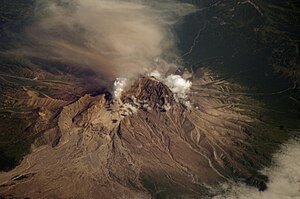Schiwelutsch
| Schiwelutsch | ||
|---|---|---|
 Schiwelutsch | ||
| Höhe | 3283 m | |
| Lage | Region Kamtschatka, Russland | |
| Dominanz | 80 km → Kljutschewskaja Sopka | |
| Schartenhöhe | 3144 m | |
| Koordinaten | 56° 39′ 12″ N, 161° 21′ 36″ O | |
| Typ | Stratovulkan | |
| Gestein | Andesit | |
| Alter des Gesteins | Jungpleistozän bis Holozän | |
| Letzte Eruption | 2010 (anhaltend) | |
Der Schiwelutsch (russisch Шивелуч) ist ein Stratovulkan auf der Halbinsel Kamtschatka im Fernen Osten Russlands, etwa 50 km nordöstlich des Dorfes Kljutschi. Es handelt sich um den nördlichsten der aktiven Vulkane der Halbinsel.
Vulkanische Aktivität
Der Vulkan entstand vor 60.000 bis 70.000 Jahren; es sind etwa 60 Eruptionen während des Holozäns bekannt.
Am 15. August 1999 begann ein erneuter Ausbruchszyklus des Schiwelutsch.
Am 28. Oktober 2010 ereignete sich eine Eruption gleichzeitig mit einem Ausbruch der in 80 Kilometer Luftlinie südwestlich gelegenen Kljutschewskaja Sopka.
Am 25. Januar 2011 wurde vom NASA-Erdbeobachtungssatelliten Terra ein Ausbruch in Form eines etwa 15 Kilometer langen pyroklastischen Stroms beobachtet.[1]
Am 4. Dezember 2017 brach der Vulkan aus und stieß eine 10 Kilometer hohe Aschewolke in die Atmosphäre.[2]
Am 24. August 2019 kam es zu einem Ausbruch mit einer ca. 5 km hohen Aschewolke.[3] Im Oktober 2019 wurde bei einem Ausbruch eine 10 km hohe Aschewolke gesichtet.[4]
Weblinks
- Schiwelutsch im Global Volcanism Program der Smithsonian Institution (englisch)
- VOLCANOES OF NORTH KAMCHATKA - Sheveluch volcano auf www.kscnet.ru (englisch)
- Statische Bilder von einer Webcam (englisch/russisch)
Einzelnachweise
- ↑ Activity at Shiveluch Volcano auf der Website der NASA (englisch)
- ↑ Kamchatka Volcanic Eruption Response Team
- ↑ Kamchatka Volcanic Eruption Response Team, 26. August 2019
- ↑ n-tv NACHRICHTEN: Russischer Vulkan Schiwelutsch ist aktiv. Abgerufen am 1. November 2019.
Auf dieser Seite verwendete Medien
Autor/Urheber: Nzeemin, Lizenz: CC BY-SA 3.0
Физическая карта Камчатского края, Россия.
- Координаты для GMT: -R148.26/179.26/48.27/67.73
- Инструменты: GMT, Inkscape
Photo of the Shiveluch volcano from the International Space Station.


